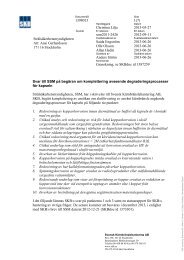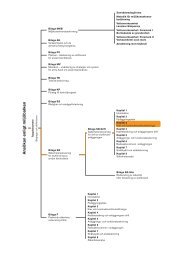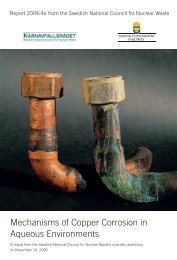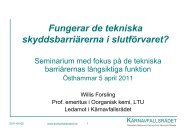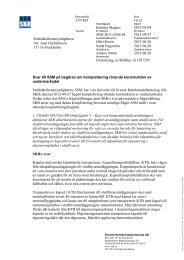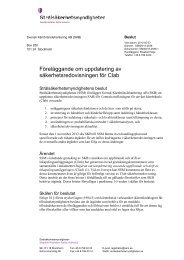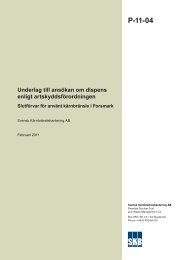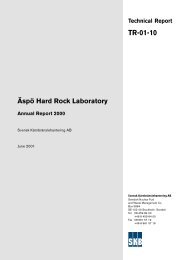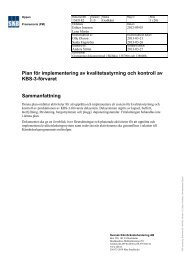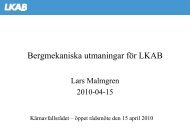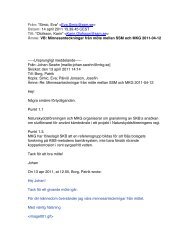Surface finish of copper Composition of solution
Surface finish of copper Composition of solution
Surface finish of copper Composition of solution
Create successful ePaper yourself
Turn your PDF publications into a flip-book with our unique Google optimized e-Paper software.
Corrosion Science, Vol. 29, No. 11/12. pp. 1371-1377, 1989 0010-938X/89 $3.00+ 0.110Printed in Great Britain© 1989 Pergamon Press pieCOMMENTS ON HYDROGEN EVOLUTION FROM THECORROSION OF PURE COPPERG. HULTQUIST,* G. K. CHUAH+ and K. L. TAN~<strong>Surface</strong> Science Laboratory, Faculty <strong>of</strong> Science, National University <strong>of</strong> Singapore,Kent Ridge, 0511 SingaporeAbstract--Some comments are given on the experimental conditions in two recent communications in thisjournal which deal with <strong>copper</strong> corrosion in water. Also some additional experimental information andthermodynamic considerations on a possible hydrogen release from <strong>copper</strong> in water is given, including avery simple and straightforward experiment.INTRODUCTIONTHE EXPERIMENTAL results on hydrogen release from the corrosion <strong>of</strong> <strong>copper</strong> in waterin communications I and 2 seem to be in total contradiction. The reason for this mightbe found in differences in the experimental conditions shown in Table 1. Somecomments on the differences are given here but also the results from some additionalexperiments and thermodynamic considerations are presented.SOME DIFFERENCES IN EXPERIMENTAL CONDITIONS<strong>Surface</strong> <strong>finish</strong> <strong>of</strong> <strong>copper</strong>The same bulk <strong>copper</strong> material seems to have been used in both studies but thesurface <strong>finish</strong> was probably different. A smoother, air-formed oxide, could havebeen present in Ref. 1 while a relatively rough oxide-free surface, was used in Ref. 2.In the production process <strong>of</strong> the <strong>copper</strong> sheets, bright annealing in a hydrogenatmosphere could have been used. In such a case hydrogen might have beenintroduced in a thin surface zone which could have suppressed the corrosion <strong>of</strong> themetal in Ref. 1 if this zone was not removed.<strong>Composition</strong> <strong>of</strong> <strong>solution</strong>In Ref. 1 0.3 1 <strong>of</strong> water containing 8 g 1 -I NaCl was used and in Ref. 2 1.2 ! distilledwater. The NaCI addition will increase the amount <strong>of</strong> <strong>copper</strong> going into <strong>solution</strong>which could increase the pH leading to a lower corrosion rate. The protectiveproperties <strong>of</strong> the reaction products adhering to the <strong>copper</strong> surface can be different inthe two <strong>solution</strong>s.* Present address: Department <strong>of</strong> Physics, National University <strong>of</strong> Singapore. On leave from Department<strong>of</strong> Physical Chemistry, The Royal Institute <strong>of</strong> Technology, S-100 44 Stockholm, Sweden.+ Department <strong>of</strong> Chemistry, National University <strong>of</strong> Singapore.-Department <strong>of</strong> Physics, National University <strong>of</strong> Singapore.Manuscript received 2 July 1988; in amended form 7 December 1988.1371
1372 G. HULTQUIST et al.TABLE 1. SOME EXPERIMENTAL CONDITIONS AND RESULTS PRESENTED IN REF. 1 AND REF. 2Conditions/results Ref. 1 Ref. 2SolutionVolume <strong>of</strong> <strong>solution</strong>TemperatureDurationTechnique for hydrogen detectionForm <strong>of</strong> hydrogen detectedOxygen conc. in gas at start <strong>of</strong> experimentOxygen conc. in gas at end <strong>of</strong> experimentHydrogen conc. in gas at end <strong>of</strong> experimentPurity <strong>of</strong> <strong>copper</strong> usedCopper surface area<strong>Surface</strong> <strong>finish</strong> <strong>of</strong> <strong>copper</strong>Weight change <strong>of</strong> <strong>copper</strong>Copper content in <strong>solution</strong> at end <strong>of</strong>experiment8000 mg 1 -~ NaCI distilled water0.31 1.2150 and 80°C 25°C1008 h 1100 hgas chromatography electrolyte probemolecularatomic and molecular99.7%2400 cm 2 1460 cm 2-- mech. pol. 800mesh SiC paperloss 0.4 4- 0.5 mggain 21.2 _+ 0.5 mg--
Hydrogen evolution from pure <strong>copper</strong> corrosion 1373The <strong>copper</strong> content in <strong>solution</strong> at the end <strong>of</strong> the experimentIn Ref. 2 a concentration <strong>of</strong>
Hydrogen evolution from pure <strong>copper</strong> corrosion 1375(ram)1"0 voltmeterE.o-G.qD~\\ %.-o.,,~.~,° "o-~lb _ ~0_ _O...O ~ •- -'o" - oCuGLoss tubewith Pt-tnpO --200o• ~,el '~" /~ ~,~ .q~-o FeZnpd to.1 I iE2 -400"oItAirlot stort)c-6-600ItI(respectivelyw~thout)~20a_I 1 1200 400 G00Time <strong>of</strong> immersion (h)FIG. 2.Experimental arrangement for study <strong>of</strong> metal corrosion and the results from astudy <strong>of</strong> <strong>copper</strong>, iron and zinc.PRIMARY REACTIONS IN THE METAL--WATER SYSTEMAND SOME THERMODYNAMIC CONSIDERATIONSThe corrosion rate <strong>of</strong> a metal is the amount <strong>of</strong> metal leaving its metallic state pertime unit. 7 The value <strong>of</strong> the concept <strong>of</strong> applying a thermodynamic forecast <strong>of</strong> themaximum degree <strong>of</strong> corrosion is limited to well defined reaction products and theirthermodynamic data. For example, the results presented in Table 2 imply that theequilibrium molecular hydrogen concentration calculated according to:H20 + 2Cu --~ Cu20 + H, (1)is not relevant for a system without atmospheric oxygen since the corrosion productformed in the absence <strong>of</strong> atmospheric oxygen is <strong>of</strong> a far more complex nature thanCu20.The role <strong>of</strong> atmospheric oxygen in metal corrosion in water is still not wellunderstood. An attempt to contribute to the knowledge <strong>of</strong> this relatively simplesystem has been made by probing hydrogen (molecular + atomic) in water exposure<strong>of</strong> Cu, Fe and Zn. 4 The conclusion in that study concerning hydrogen was that atomicand/or molecular hydrogen is released when <strong>copper</strong>, iron or zinc is immersed in waterand that takes place mainly after atmospheric oxygen has been consumed.We have tried further to clarify the primary reactions taking place during theexposure <strong>of</strong>Cu, Fe, Zn and Zr to water by using SIMS. In Table 3 results on detectedspecies from Cu, Fe, Zn and Zr upon exposures <strong>of</strong> these metals to different gascompositions are presented. An increase in the MeOH + species is found upon water
1376 G. HULTQUIST et al.TABLE 3. NORMALIZED INTENSITIES MeX+/Me ÷ OF SPECIES DETECTED UPON EXPOSURES OFZr, Zn, Fe AND Cu METALS TO VARIOUS GASES. SIMS Ar + 6 kV 3 nA 10 -~ cm 2Gas composition (mbar)ZrH + ZrO + ZrOH + ZnH + ZnO + ZnOH + H2 H20 0 20.045 1.73 0.860 0.42 0.026 0.137 3 x 10 -9 1 x 10 -7 5 x 10 -210.063 0.63 0.009 0.19 0.023 0.023 1 x 10 7 1 x 10 -9 4 x 10 120.039 0.72 0.007 0.07 0.021 0.026 2 x 10 9 2 x 10 -~ 1 x 10 -7Fell + FeO + FeOH + Cull + CuO + CuOH + H2 H20 020.049 0.0055 0.022 0.0029 0.0005 0.0029 3 x 10 -~ 1 x 10 -7 5 x 10 110.006 0.0089 0.003 0.0015 0.0005 0.0010 1 x 10 -7 1 x 10 _9 4 x 10 -120.005 0.0018 0.004 0.0004 0.0015 0.0008 2 x 10 -9 2 x 10 _9 1 x 10 -7exposure. This is the case for all the four metals. Furthermore it should be noted thatZnH +, Fell + and Cull + values are higher in water exposure than in H2 exposure.Upon oxygen exposure the lowest values <strong>of</strong>MeH + appear for all the metals studied.Based on these results and from other studies 2'4'8 we find that the primary reactionsteps for <strong>copper</strong> exposed to water are in accordance with the general description:Me + H20 --~ Me(HzO)ads --~ MeOH + H (2)or in the terminology <strong>of</strong> electrochemistryMe + OH- ~ MeOH + e (3)H + + e ~ H. (4)Since we also find Cu2OH + species in addition to CuOH ÷ upon water exposure <strong>of</strong><strong>copper</strong> in SIMS 9 we also consider:2Cu + H20 ~ 2Cu(HzO)ads ---) Cu2OH + H (5)as a primary reaction for <strong>copper</strong> exposed to water.For <strong>copper</strong> step (2) can be followed byorand (5) can be followed by2CuOH ~ Cu20 + H20 (6)CuOH~CuO + H (7)Cu2OH---) Cu2O -+- H. (8)In general the atomic hydrogen formed in (4), (5), (7) and (8) can follow variouspathways:(i) Atomic hydrogen can combine with atmospheric oxygen at surface sites:H+ ~O2~OH ~ or 2H + ~O ' 2 ---+ H20. (9)(ii) Atomic hydrogen can form molecular hydrogen at surface sites:H + H~H2. (10)
Hydrogen evolution from pure <strong>copper</strong> corrosion 1377(iii) Atomic hydrogen can enter the metal Me.(iv) Atomic hydrogen can, via surface diffusion and/or desorption, reach othermaterial and further via volume diffusion escape from the corroding system ifthis material constitutes the enclosure <strong>of</strong> the system.The equilibrium between atomic and molecular hydrogen in the gas phase is-1 : 1() 3s which means that upon H2 exposure the activity <strong>of</strong> atomic hydrogen on asurface is crucially dependent upon the ability <strong>of</strong> the surface to dissociate molecularhydrogen to atomic hydrogen. According to Ref. 10 <strong>copper</strong> does not dissociatemolecular hydrogen on low index single crystal surfaces. It is also evident in Table 3that the activity <strong>of</strong> hydrogen on <strong>copper</strong> upon exposure to 10 -7 mbar molecularhydrogen is insufficient to prevent CuOH formation.In ref. 2 an attempt was made to calculate the position on the hydrogen scale <strong>of</strong> amodified reversible hydrogen electrode:H + + e ~-~ H ~ IH 2 (11)in which the H 2 concentration equals the He concentration in (sea) water, in aircontact, and for reactions involving one electron transfer as in (4). A displacement <strong>of</strong>9 × 60 = 540 mV <strong>of</strong> the hydrogen electrode in the potential -pH diagram wasmentioned which means 120 mV vs SHE at pH 7 while 9 × 30 = 270 mV displacementcorresponds to reactions like (1). The oxidation potential for <strong>copper</strong> to Cu:O is




